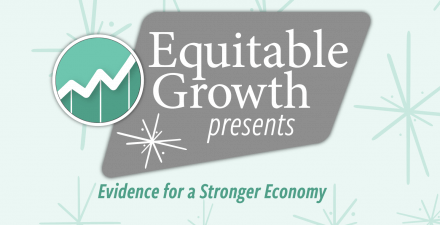Overview
Equitable Growth in Conversation is a recurring series where we talk with economists and other academics to help us better understand whether and how economic inequality affects economic growth and stability. In this installment, Equitable Growth Director of Family Economic Security Alix Gould-Werth speaks with Mark Rank, the Herbert S. Hadley professor of social welfare at Washington University in St. Louis, where he studies issues of poverty, inequality, and social justice in the United States. His research on the life-course risk of poverty demonstrates that a majority of Americans will experience poverty at some point during their lives, providing a new understanding of poverty and inequality, and the role of luck and chance in shaping the course of our lives. His latest book, with co-authors Heather Bullock, a psychology professor at the University of California, Santa Cruz, and Lawrence Eppard, a sociologist at Shippensburg University, is titled Poorly Understood: What America Gets Wrong About Poverty.
In a recent conversation, Gould-Werth and Rank discuss:
- How to usefully measure poverty in the United States
- The actual causes of poverty
- Poverty and race and ethnicity
- Poverty and the broader U.S. macroeconomy
- Myths about poverty and their consequences
- Poverty and policymaking
- Poverty and inequality in the United States
Alix Gould-Werth: I am here today with Mark Rank, and I am so glad that you are able to join us. Thanks for being here.
Mark Rank: Thanks for having me.
Gould-Werth: I want to jump right into the conversation because there’s a lot that’s interesting in your research that I’d like to cover. The first question I have is about the popular imagination of poverty and how it does or doesn’t contrast with what you find in your research.
When we look at the way poverty is portrayed in the popular media, we often see a picture of a static and permanent underclass. There’s the idea that poverty is something that only affects a small proportion of the population and that people who experience poverty usually can’t escape it. They’re stuck there.
So, I’m interested in knowing what your research shows about the actual chances of experiencing poverty and how long people would experience it for.
Rank: That’s a great place to start. You’re absolutely right that the popular idea out there is one, that folks who experience poverty are there for long periods of time. The other image is that poverty happens to somebody else, but it doesn’t happen to me. Much of the research that has been conducted focuses on the percent of the population that is poor in any given year, and that varies between 10 percent and 15 percent.
But a number of years ago, my colleague Tom Hirschl [a sociologist at Cornell University] and I wanted to look at the question, “What is the long-term risk of people experiencing poverty over the course of 20, 30, 40 years?” And so, we’ve been engaged in research addressing the question of the life chances of experiencing poverty. And it turns out that a clear majority of Americans, at some point during their adulthood, will experience poverty. And by poverty, we’re using the official U.S. definition of falling below a certain income level. It’s a pretty conservative measure.
What we find is that between the ages of 20 and 75, nearly 60 percent of Americans will experience at least 1 year in poverty, and three-quarters of Americans will experience either poverty or near-poverty.
What this research shows is that rather than thinking about poverty as an issue that happens to somebody else, we really should think about it as an issue that happens to many of us.
One question that people often ask is why are those numbers so large? That’s a pretty significant percentage of the population, but if you think about it, over the course of 20, 30, 40 years, things happen to people that they didn’t anticipate. Folks might lose a job, a family might split up, the breadwinners might get sick, or a pandemic might happen. All of these events have the potential to throw individuals into poverty. So, when you look over long periods of time, poverty is unfortunately a normative event in the United States.
How to usefully measure poverty in the United States
Gould-Werth: That’s a large proportion of us who are going to experience poverty, and I was struck by the different figures you gave for falling under that official poverty threshold, and then the three-quarters who will experience near-poverty. Can you tell me a little bit more about which metric you think is more useful for considering who is actually experiencing what we popularly imagine as being poor?
Rank: I teach a course on poverty here at Washington University every semester, and that’s one of the things that we start with: What’s the best way to think about this? In a lot of this research, we use the official poverty line because that is the official way in which poverty is measured in the United States. But it’s a very conservative measure. I think most people would agree. In 2021, for a family of three, if you fall below around $22,000, you are considered in poverty. It’s very hard for anybody trying to survive on $22,000 for a family of three.
The other thing that we should keep in mind is that the official poverty line represents poverty at its most opulent level. It turns out that 45 percent of folks in poverty fall below half the official poverty line. So, for a lot of our life-course research on poverty, Hirschl and I use the poverty line, but in addition, we use below 150 percent of the poverty line to capture near-poverty households, which is probably a more reasonable measure of hardship.
The other measure that I like to use when comparing the United States to other countries is what’s known as a relative poverty measure. Most European countries use as this type of measure. A specific relative poverty measure is one that calculates how many people fall below one-half of the median income. When you use that kind of measure, you can then compare countries and look at how they vary in terms of how many folks are in poverty.
There are also other ways of thinking about poverty that go beyond economic measures. For example, what does poverty represent in people’s lives? In some European countries, the discussion is one of social exclusion and deprivation. That reflects a more qualitative idea of what poverty means.
Gould-Werth: This is really helpful, and with a lot of really good nuance about different buckets researchers use to think about what it means to experience poverty. What I’m taking away from it overall is that it’s a really high proportion of people in the United States who will have some kind of experience that propels them into a place where they’re not going to be able to meet their basic needs with their income. Did I get right?
Rank: That’s absolutely right. Thinking back to the question of how we compare to other countries, the United States is at the very high end in terms of the extent of its poverty and the depth of its poverty, compared to other OECD countries. Why is that?
One reason is because when events such as losing a job happen to people in the United States, there’s very little to protect them from falling into poverty, whereas other countries have more programs and policies in place that protect people. They have a stronger social safety net. They have universal healthcare. They have a variety of things that protect people, whereas in the United States, if these things happen, there’s not much of a safety net, and so the chances of experiencing poverty are much greater.
Definitely one of the things that separates the United States from other countries is what we fail to provide in the way of protections in order to catch people from falling into poverty. In fact, I would argue that our policies are designed to punish people who experience poverty. For example, it’s really difficult to get these programs, and they provide very little financial assistance.
The actual causes of poverty in the United States
Gould-Werth: This makes you think again about the idea in the popular imagination about personal responsibility—that poverty is a direct result of that person’s choices and actions or their inactions, and that the solutions for poverty rest with individuals. Could you dive a little deeper into what you see as the actual causes, whether at the individual or societal level and what that implies for what policymakers should do to alleviate poverty?
Rank: The way that we generally have understood the causes of poverty in the United States has been as an individual failing. People aren’t working hard enough. They’ve made bad decisions. They’re not motivated. They haven’t gotten enough education and skills. All of these are variations on the idea that poverty is an individual failing.
In fact, that’s how we view most social problems in the United States, as an individual failing. What we argue in our new book, Poorly Understood: What America Gets Wrong About Poverty, is that poverty is actually a structural failing. It has to do with our economy not producing enough decent paying jobs. It has to do with our political and policy structures that don’t provide strong social safety net programs.
Here’s the way I like to illustrate this to really bring it to life: What we’re doing in this country is playing a game of musical chairs, where we have 10 players but only eight chairs available. Players circle around, the music stops, and who loses out?
Well, in terms of who lost that game, those two people might have been in a bad position when the music stopped. They might not have been as quick or as agile. And we can point to these reasons as to why those two folks lost out. But if we step back and say wait a minute, the structure of the game is set up such that two people are going to lose out, then those individual characteristics only explain who loses out of the game, not why the game produces losers in the first place.
We can think of poverty in the United States as a large-scale version of musical chairs where there are more players than there are chairs available. The players who don’t have chairs might have less education or are single parents, and are therefore more likely to experience poverty. But given that there are not enough chairs available, someone is going to lose out.
One important reason why there aren’t enough chairs is that the economy doesn’t produce enough jobs that pay a decent wage. About 40 percent of all jobs in the United States today are considered low-paying jobs. Folks can be working at these jobs and still be struggling. What we do in terms of our policies is that we continually focus on the characteristics of who loses out, not why the game is producing losers in the first place.
Another way to imagine this is education. Education is really important for a variety of reasons. In terms of averting poverty, education is a great individual strategy for that individual to reduce their chances of poverty, but as a macroeconomic strategy, all we’re doing is shuffling people around unless we increase the number of opportunities. We’re making some people more competitive at the expense of other people. Our policies have focused on this idea of strengthening individual characteristics but not changing the structure of the game.
Poverty and race and ethnicity in the United States
Gould-Werth: I want to return to the metaphor about the game of musical chairs with specific people losing and also why the chairs are removed. I want to do that by bringing race into the conversation. A lot of times, I think, in the popular portrayal of poverty, we think about the people who experience poverty as being Black and Latino, but then, I think about how larger-scale racism in our society shapes our safety net and what is available to pull all people out of poverty. I’m interested in your view of how race shapes both who loses out and the number chairs that are available.
Rank: You can’t talk about poverty in the United States and inequality in the United States without talking about race. Clearly race is important, and race comes into play in terms of thinking about the structure of the game and that certain players are at a disadvantage in terms of race and ethnicity. So, it’s really critical to keep in mind that racism and discrimination are important structural factors that affect an individual’s risk of poverty.
What’s more, race has been used in the United States over and over to divide the interests of poor Whites and poor Blacks. We have a quote in our book that is very poignant in terms of how race has been used to divide. It’s from President Lyndon Johnson in 1960. He was talking to an aide at that time, and here’s what he says:
I’ll tell you what’s at the bottom of it. If you can convince the lowest White man that he’s better than the best colored man, he won’t notice you picking his pocket. Hell, give him somebody to look down on and he’ll empty his pockets for you.
That’s exactly what has happened in the United States. Race has been used to divide, again, poor Whites and poor Blacks from seeing their common interests. And we don’t have to look any further than the previous president of the United States, who used race and ethnicity all the time to do this.
So, race and discrimination are a double-edged sword. They play an important part in terms of affecting folks of color and their risk of experiencing poverty. And they have been used strategically by politicians to divide Americans rather than seeing their common interests. And this has been particularly the case in the South, where this strategy has been used for many decades.
Gould-Werth: So, to extend your metaphor, there are White people who end up in those two missing chairs even though most people often think that it’s only Black and Latino people.
Rank: Yes.
Gould-Werth: Yet it’s also true that people of color are at greater risk of landing without a chair than a White person.
Rank: Yes.
Gould-Werth: And because of that, we lose some of the momentum to argue to put those two missing chairs back into the game.
Rank: Yes, that’s a very good way of putting it. And that’s a way of looking at this double-edged sword of race. I’ll have to remember that. I’ll keep that in mind.
Poverty and the broader U.S. macroeconomy
Gould-Werth: I also want to pull more at a string that I noticed when you were discussing the broader U.S. economy. You spoke about how when the broader macroeconomy isn’t producing good-paying jobs, we see increases in poverty. At Equitable Growth, we often flip that on its head to think about challenges such as poverty as something that can actually affect the macroeconomy and economic growth. So, I’m interested in the cost of poverty to the wider U.S. economy and how addressing poverty through some of our policy levers could affect the strength of the economy as a whole.
Rank: There are a couple different points I want to make here. One is that by not investing in our human capital, in our citizens, and in their development, our economy is not as productive as it could be. We know that poverty in general results in higher social and economic costs. What are those costs? Children raised in poverty are not as economically productive as adults. And we know that poverty is associated with higher criminal justice cases and incarceration, the costs of which are very, very expensive.
In the book, we add up those numbers to determine what the cost of childhood poverty in the United States is, and find that on an annual basis, the dollar cost is slightly more than $1 trillion a year. To put that in perspective, that was about 28 percent of the entire federal budget in 2015.
So, the question is not whether we’re paying for poverty, but rather how we’re paying for poverty. And we’re paying for it on the back end of the problem rather than the front end of the problem. And whenever you pay for something on the back end of the problem, it’s always much more expensive than preventing the problem in the first place.
The other thing that we show is that for every dollar we spend on reducing childhood poverty, we would save between $7 and $12 down the road in averting these costs. Therefore, reducing childhood poverty is not only the morally right thing to do, but it’s also economically the smart thing to do.
The myths of poverty and their consequences
Gould-Werth: That makes a lot of sense. Throughout our conversation, you’ve been referring to your new book, Poorly Understood: What America Gets Wrong about Poverty, and it’s about the myths of poverty. Writing a book is a lot of work. So, why did you decide you wanted to write the book, and what do you hope readers take away from it?
Rank: This book really came about with a conversation with one of my co-authors, Lawrence Eppard. We were talking about whenever you get into this field, you run into these myths all the time, and we realized that there hadn’t really been a book that just focused on debunking the many myths surrounding welfare, poverty, and inequality. We thought this would be a really interesting book to do. And so, that was the impetus behind it.
I would argue that one of the reasons why we really haven’t been able to effectively address poverty in this country is because we’ve misunderstood it as a result of all these myths and stereotypes. The book is designed to use research in order to scrutinize the misperceptions that are out there. Basically, we show that there is very little evidence for any of these myths. What our social policies have been doing in the past is like a doctor who has misdiagnosed a patient, and no matter the prescription that’s given, it’s not going to make the patient any better.
In fact, it might make the patient worse. And I think that’s what’s been going on here in the United States. We have misdiagnosed the issue of poverty. We’ve looked at it as an individual failing, and we haven’t really been able to deal with these structural kinds of issues.
So, then, the interesting questions are why do they continue to do this, and why do people continue to believe these myths about poverty if there’s not much evidence? I don’t pretend that we have all the answers, but there are three authors on this book and one of them is a psychologist, Heather Bullock, and she talks about the ideas of stereotyping and confirmation bias, and the psychological reasons why this occurs. I talk about sociological reasons and who benefits from these myths. Who benefits from the myth of individual failing and that the United States is a meritocracy?
I think we could point to several different groups. Politicians have clearly benefited from these myths and have used them to score political points. Ronald Reagan. Bill Clinton. Donald Trump. They’ve all used this.
But another interesting group that I think has benefited from these myths are those who are at the top because basically if you believe these myths, then there’s really nothing we need to do. It’s the individual’s fault. It doesn’t have anything to do with the structure of society. But if that’s not the case, then we really do need to do something structurally and that’s threatening to folks at the top. And so, it’s much more convenient to believe in these myths than to face the truth.
Poverty and policymaking
Gould-Werth: I’m wondering now about your diagnosis. What’s the treatment? What would you recommend to policymakers who are trying to design anti-poverty policies?
Rank: If the diagnosis is there is something structurally wrong here, rather than individual failing, then we need to do some structural kinds of things. One of the main structural problems is that there aren’t enough jobs that pay a livable wage that can support families. So, I think there are lots of things we could do. And actually, I’m guardedly optimistic that in the policy arena right now, people are talking about these ideas.
One obvious thing would be to raise the minimum wage to a livable wage, to something like $15 an hour. That would certainly help a number of folks who are earning below that level. Another way to raise the wages of low-income earners is through the Earned Income Tax Credit.
Then, there’s the interesting idea of child allowances. They’ve been in use in European countries for decades, but here, this is a pretty radical idea. Yet President Joe Biden put it in his pandemic relief package, and Sen. Mitt Romney [R-UT] proposed a similar idea. This means there’s perhaps something in the wind here. And that’s a very direct way of dealing with poverty, by saying if you have children, we’re going to provide you with some monthly cash to help you raise those children. That’s a very effective way to reduce poverty, and recent research shows that child allowances would have a pretty dramatic impact on reducing childhood poverty.
I also think there are larger structural issues that need to be addressed. And when we’re talking about safety net programs, there is a broader range of things that we really don’t do in this country that we should be doing. One is universal healthcare. I think it’s wrong that healthcare should be dependent on the size of your wallet. And we could make child care and housing more affordable and accessible. That again is what many other countries do.
The last thing I’ll say is we can also support lower-income individuals and families in terms of allowing them to build their assets. We do that with middle- and upper-income folks. They can deduct their home mortgage interest. That allows them to build their assets in their homes. But we need to think about policies on the lower end of the income distribution that will allow people to build their assets as well.
So, let’s address some of these structural issues. And again, as I said, I am guardedly optimistic that we actually are beginning to think along these lines. So, that’s quite positive.
Poverty and inequality in the United States
Gould-Werth: I feel like it’s so unusual to get to the end of a conversation about these types of issues on a note of optimism. I feel happy about that. I’m wondering if you have any last thing you want to add.
Rank: I think one interesting thing that we haven’t talked about is the issue of inequality, which is a little different than poverty. As you know inequality has been getting wider in the United States. There’s less economic mobility. It’s becoming harder for each generation to do better than the previous generation. And these are all really, really important issues that cut across a wide spectrum of the income distribution.
We’re not just talking about poverty here. We’re talking about the 80 percent to 90 percent of the population who are affected by inequality, who have been struggling to keep their heads above water over the past 30 years to 40 years or so. This is something we discuss in our new book.
Gould-Werth: I love that this is in the book, and that as part of your framing, you use a kind of stylized fact about the increasing divergence or increase in inequality since the 1970s. This stylized fact also motivates the existence of our organization, the Washington Center for Equitable Growth. Like I said earlier, Equitable Growth examines not just how we can make policy interventions to decrease inequality, but also what inequality is doing to the health of the U.S. economy as a whole. We look both at changes at the top and the bottom of the distribution as ways to have a more vibrant economy and less poverty altogether.
Rank: I have an economist colleague at Washington University, Steven Fazzari, with whom I teach a course every year. It’s called the Economic Realities of the American Dream, and it’s about these things you are talking about. We show that increasing inequality does have a drag on overall economic productivity. So, it really hurts us all to have this widening inequality. And it’s gotten more extreme from the 1970s on. So, I am right in tune with what you guys are doing.
Gould-Werth: Well, I feel like that might be the right note to end the conversation on. We have hope for poverty, but we’re stuck in this unequal society. Thank you so much for taking the time to talk with me today. It’s been a real treat to get to engage with your work.
Rank: This was great. Thanks.
Related
Explore the Equitable Growth network of experts around the country and get answers to today's most pressing questions!







